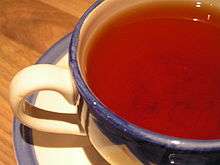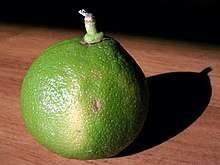Earl Grey tea
Earl Grey tea is a tea blend which has been flavoured with the addition of oil of bergamot. The rind's fragrant oil is added to black tea to give Earl Grey its unique taste.[1] Traditionally, Earl Grey was made from black teas such as China keemun and therefore intended to be drunk without milk. However, tea companies have since begun to offer Earl Grey based upon stronger teas such as Ceylons which are better suited to the addition of milk or cream. Other varieties have been introduced as well, such as green or oolong.[2]


History

The Earl Grey blend, or "Earl Grey's Mixture", is assumed to be named after Charles Grey, 2nd Earl Grey, British Prime Minister in the 1830s and author of the Reform Bill of 1832. He reputedly received a gift, probably a diplomatic perquisite, of tea flavoured with bergamot oil.[3] A "Grey's Tea" is known from the 1850s, but the first known published references to an "Earl Grey" tea are advertisements by Charlton & Co. of Jermyn Street in London in the 1880s.[4]
According to one legend, a grateful Chinese mandarin whose son was rescued from drowning by one of Lord Grey's men first presented the blend to the Earl in 1803. The tale appears to be apocryphal, as Lord Grey never set foot in China[5] and the use of bergamot oil to scent tea was then unknown in China. However, this tale is subsequently told (and slightly corrected) on the Twinings website, as "having been presented by an envoy on his return from China".[6]
Jacksons of Piccadilly claim they originated Earl Grey's Tea, Lord Grey having given the recipe to Robert Jackson & Co. partner George Charlton in 1830. According to Jacksons, the original recipe has been in constant production and has never left their hands. Theirs has been based on Chinese black tea since the beginning.[7][8]
According to the Grey family, the tea was specially blended by a Chinese mandarin for Lord Grey, to suit the water at Howick Hall, the family seat in Northumberland, using bergamot in particular to offset the preponderance of lime in the local water. Lady Grey used it to entertain in London as a political hostess, and it proved so popular that she was asked if it could be sold to others, which is how Twinings came to market it as a brand.[9]
A 2010 survey found that a significant minority of people in the United Kingdom associate drinking Earl Grey tea with being "posh" or upper class.[10][11]
Preparation and variations

"Earl Grey" as applied to tea is not a registered trademark,[12] and numerous tea companies produce their own versions of Earl Grey tea, using a wide variety of tea leaves and additives.
Bergamot orange (Citrus bergamia) is a small citrus tree which blossoms during the winter and is grown commercially in Calabria, Italy.[13][14] It is probably a hybrid of Citrus limetta (sweet lime) and Citrus aurantium (bitter orange).[15]
- There are different varieties of a tea known as Lady Grey; the two most common kinds being cornflower Lady Grey and citrus Lady Grey, which combine Earl Grey tea with cornflower and Seville oranges, respectively. "Lady Grey" is a trademark of Twinings.[16]
- A beverage called "London Fog" is a combination of Earl Grey, steamed milk and vanilla syrup.[17]
- There are variations available including such ingredients as jasmine, as well as various flowers.[18] A blend with added rose petals is known as French Earl Grey, which has become the most popular blend at Australian tea store T2.
- A variety called Russian Earl Grey often contains ingredients such as citrus peels and lemon grass in addition to the usual black tea and bergamot.
- Also, several companies make a tea called Earl Grey Green or "Earl Green" tea, combining green tea leaves rather than the traditional black tea leaves with bergamot flavouring. A similar variation called Earl Grey White or "Earl White" tea combines white tea leaves with bergamot flavouring.
- Rooibos Earl Grey is a variation using this South African herbal tea as a substitute for the conventional form made with black tea.
- Fortnum & Mason produce Smoky Earl Grey, containing bergamot, Lapsang Souchong, and Gunpowder tea. It is reputedly the favoured tea of Queen Elizabeth II.
Use as a flavouring
Earl Grey tea is used as a flavouring for many types of cakes and confectionery, such as chocolates, as well as savoury sauces.[19][20] For sauces, the flavour is normally created by adding tea bags to the basic stock, boiling for a few minutes and then discarding the bags. For sweet recipes, loose tea is often added to melted butter or hot cream and strained after the flavour is infused.[21][22][23]
Toxicology
In several studies, application of high concentrations of some brands of bergamot oil directly to the skin was shown to increase redness after exposure to ultraviolet light;[24][25] however, this should not apply to ordinary oral consumption of Earl Grey tea. Bergamot is a source of bergamottin which, along with the chemically related compound 6',7'-dihydroxybergamottin, is known to be responsible for grapefruit–drug interactions in which the consumption of the juice affects the metabolism of a variety of pharmaceutical drugs.[13][26]
In one case study, a patient who consumed four litres of Earl Grey tea per day reported muscle cramps, which were attributed to the function of the bergapten in bergamot oil as a potassium channel blocker. The symptoms subsided upon reducing his consumption of Earl Grey tea to one litre per day.[13][27]
Footnotes
- Richardson, Ben (6 April 2006). "Bergamot growers get whiff of success". BBC News. Archived from the original on 26 November 2010. Retrieved 7 December 2010.
- Jane Pettigrew (Mar 7, 2014). Tea Classified: A Tealover's Companion. Pavilion Books.
- Kramer, Ione. All the Tea in China. China Books, 1990. ISBN 0-8351-2194-1. Pages 180-181.
- "Foods of England". Archived from the original on 20 January 2013. Retrieved 1 January 2013.
- Pettigrew, Jane (2004). The Tea Companion: A Connoisseur's Guide (Connoisseur's Guides). Philadelphia, Pa: Running Press Book Publishers. ISBN 0-7624-2150-9.
- "Earl Grey". Twiningsusashop.com. Archived from the original on 2010-08-15. Retrieved 2010-12-07.
- Fenix, Micky (24 July 2008). "More Than Just A Pot Of Tea". Philippine Daily Inquirer. Archived from the original on 20 January 2013.
Stephen Twining traced back his family's business to the 1700s, when coffee houses as meeting places were the vogue. How ironic that it was in the company's coffee house where tea was introduced. Earl Grey tea makes Stephen Twining wish he could move back time because the company did not lay claim to the formula, or the name, when they had produced the blend for the British Prime Minister who was known as the second Earl Grey.
- Pagano, Margareta (3 July 1985). "The secret of Earl Grey tea is changing hands at last / Sale of Jacksons of Piccadilly to Fitch Lovell food manufacturing group". The Guardian (London).
The original secret formula for Earl Grey tea is changing hands after 155 years with its sole proprietors, the Jacksons of Piccadilly tea merchants... with the sale goes the special recipe of the Earl Grey blend which was entrusted to Robert Jackson's partner, George Charlton, in 1830 by the second Earl Grey. To this day the formula—which mixes black China tea with other unknown teas—has remained unaltered.
- "Earl Grey Tea House at Howick Hall Gardens". Howick Hall Gardens. Archived from the original on 2010-12-27. Retrieved 2011-01-28.
- "Want to seem posh? Employ a cleaner and drink Earl Grey". The Telegraph. Archived from the original on 2018-05-27. Retrieved 2018-04-02.
- "Survey Results". 20 May 2010. Archived from the original on 4 January 2017. Retrieved 15 Jan 2016.
- "Review: Twinings Earl Grey tea". Archived from the original on 2014-12-22. Retrieved 2014-12-01.
- Houston, Muiris (30 September 2002). "Have your cuppa, but go easy on the Earl Grey". The Irish Times.
...Bergamot contains the psoralen derivatives bergapten and bergamottin. The adverse effects of bergamot oil in this patient are explained by the action of bergapten as a potassium channel blocker within muscle cells. By interrupting the normal flow of potassium, the cells become hyperexcitable, leading to the visible movements and cramps within the muscles. By drinking four litres a day of Earl Grey (equivalent to at least 16 cups of tea), the Austrian man was simply overdosing on essence of bergamot.
- "Citrus bergamia". Germplasm Resources Information Network (GRIN). Agricultural Research Service (ARS), United States Department of Agriculture (USDA). Retrieved 11 December 2017.
- "RFLP Analysis of the Origin of Citrus Bergamia, Citrus Jambhiri, and Citrus Limonia". International Society for Horticultural Science. Archived from the original on 12 March 2012. Retrieved 18 February 2012.
- "Justicia trademark database". Archived from the original on 2014-12-04. Retrieved 2014-12-01.
- Nye, Valerie; Barco, Kathy (2009). Breakfast New Mexico Style. Sunstone Press. p. 48. ISBN 978-0-86534-716-8. Archived from the original on 2017-01-10. Retrieved 2010-12-07.
- Cooper, Nathanael (18 October 2008). "Tea for 2 or 2 for tea". Sunshine Coast Daily. Retrieved 13 November 2009.
- Joachim, David (2001). Brilliant Food Tips and Cooking Tricks: 5,000 Ingenious Kitchen Hints, Secrets, Shortcuts, and Solutions. Rodale. p. 502. ISBN 978-1-57954-301-3. Retrieved 2016-09-23.
Earl Grey shallot sauce.
- Miller, Norman (11 April 2009). "Why tea is the new spice rack must-have". The Times.
- Boyle, Tish (2002). The good cookie: over 250 delicious recipes from simple to sublime. John Wiley and Sons. p. 124. ISBN 978-0-471-38791-6. Archived from the original on 2017-01-10. Retrieved 2016-09-23.
Chocolate dipped Earl Grey shortbread wedges.
- Schneider, Edward (16 January 2002). "Cooking With Tea; "As for pears, I poached them in Earl Grey, a tea with impeccable prime ministerial credentials."". The Washington Post. Archived from the original on 25 July 2012. Retrieved 13 November 2009.
- Wareing, Marcus (7 March 2008). "Earl Grey tea cream and Eccles cakes". BBC. Archived from the original on 2008-03-07. Retrieved 13 November 2009.
- Girard, J.; Unkovic, J.; Delahayes, J.; Lafille, C. (1979). "Phototoxicity of Bergamot oil. Comparison between humans and guinea pigs". Dermatologica. 158 (4): 229–243. doi:10.1159/000250763. PMID 428611.
- Kejlová, K.; Jírová, D.; Bendová, H.; Kandárová, H.; Weidenhoffer, Z.; Kolářová, H.; Liebsch, M. (2007). "Phototoxicity of bergamot oil assessed by in vitro techniques in combination with human patch tests". Toxicology in Vitro. 21 (7): 1298–1303. doi:10.1016/j.tiv.2007.05.016. PMID 17669618.
- Bailey, D. G.; Malcolm, J.; Arnold, O.; Spence, J. D. (1998). "Grapefruit juice-drug interactions". British Journal of Clinical Pharmacology. 46 (2): 101–110. doi:10.1046/j.1365-2125.1998.00764.x. PMC 1873672. PMID 9723817.
- Finsterer, J. (2002). "Earl Grey tea intoxication". The Lancet. 359 (9316): 1484. doi:10.1016/S0140-6736(02)08436-2. PMID 11988248.
External links
| Wikimedia Commons has media related to Earl Grey tea. |
| Wikiquote has quotations related to: Earl Grey tea |